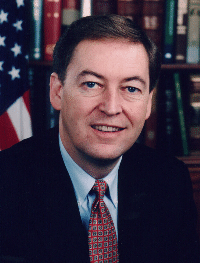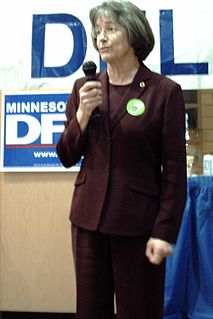
Rodney Dwight "Rod" Grams was an American politician from Minnesota. He served as a Republican in both the United States House of Representatives and the U.S. Senate.
Joanne E. Benson was the 44th lieutenant governor of Minnesota, serving from January 3, 1995, to January 4, 1999. An Independent Republican, she was elected with Governor Arne Carlson, who had competed for the party endorsement with Allen Quist and Doug McFarland, and defeated DFL nominee John Marty. Benson is a former Minnesota state senator noted for being somewhat more conservative than the moderate Carlson.

The 2006 Minnesota gubernatorial election took place on November 7, 2006. Incumbent Tim Pawlenty was endorsed by the state Republican convention on June 2, 2006, while the state Democratic–Farmer–Labor convention endorsed Mike Hatch on June 10, 2006. The party primaries took place on September 12, 2006, with Hatch defeating DFL challengers Becky Lourey and Ole Savior and incumbent Pawlenty defeating Sue Jeffers. In the November 7 general election Pawlenty received a plurality of the votes, defeating Hatch by a margin of one percent. As of 2019, it is the most recent time a Republican was elected governor of Minnesota, or won any statewide race.

Becky Lourey is an American politician, a former Minnesota Democratic-Farmer-Labor Party (DFL) state senator and state representative, and a former Minnesota gubernatorial candidate. Her son, Matt, served in the U.S. Army and was killed on May 27, 2005, as a result of injuries received in combat over Buhriz, Iraq, where he was serving in his second tour of duty.
Judith H. Dutcher is an American attorney and former politician who served as the Minnesota State Auditor from 1995 – 2003 as both a Republican and Democrat (DFL). She was the first woman to serve as Minnesota State Auditor.

Michael Orville Freeman is an attorney and politician from the state of Minnesota. He is currently the county attorney for Hennepin County, the most populous county in the state, of which the county seat is Minneapolis.

The 2010 Minnesota gubernatorial election was held on Tuesday, November 2, 2010 to elect the 40th Governor of the U.S. state of Minnesota for a four-year term to begin in January 2011. The general election was contested by the major party candidates State Representative Tom Emmer (R–Delano), former U.S. Senator Mark Dayton (DFL), and Independence Party candidate Tom Horner. After a very close race, Dayton was elected governor. Emmer would be elected to the United States House of Representatives four years later.
Tom Horner is a Minnesota politician and a member of the Independence Party of Minnesota. He was a candidate in the 2010 election for Governor of Minnesota.

Elections were held in Minnesota on Tuesday, November 2, 2010. Primary elections took place on August 10, 2010.

The 2012 United States Senate election in Minnesota took place on November 6, 2012, concurrently with the U.S. presidential election as well as other elections to the United States Senate and House of Representatives as well as various state and local elections. Incumbent Democratic–Farmer–Labor U.S. Senator Amy Klobuchar was re-elected to a second term in a landslide, defeating the Republican nominee, State Representative Kurt Bills by almost one million votes, and carrying all but two of the state's counties.

The 2012 United States House of Representatives elections in Minnesota were held on Tuesday, November 6, 2012 to elect the eight U.S. Representatives from the state of Minnesota. The elections coincided with the elections of other federal and state offices, including a quadrennial presidential election and an election to the U.S. Senate. Primary elections were held on August 14, 2012.

The 2014 Minnesota gubernatorial election took place on November 4, 2014, to elect the governor of Minnesota concurrently with the election to Minnesota's Class II U.S. Senate seat, as well as other elections to the United States Senate in other states and elections to the United States House of Representatives and various state and local elections.

The 2014 United States Senate election in Minnesota was held on November 4, 2014, to elect a member of the United States Senate to represent the State of Minnesota, concurrently with the election of the Governor of Minnesota, as well as other elections to the United States Senate in other states and elections to the United States House of Representatives and various state and local elections.

The 2014 United States House of Representatives elections in Minnesota took place in the U.S. state of Minnesota on November 4, 2014, to elect Minnesota's eight representatives in the United States House of Representatives for two-year terms, one from each of Minnesota's eight congressional districts. Primary elections were held on August 12, 2014.

A general election was held in the U.S. state of Minnesota on November 4, 2014. All of Minnesota's executive officers were up for election as well as all the seats in the Minnesota House of Representatives, several state judicial seats, a United States Senate seat, all of Minnesota's eight seats in the United States House of Representatives, and several seats for local offices. A primary election was held on August 12, 2014, to nominate major political party candidates for partisan offices and candidates for nonpartisan offices.

The 2014 Minnesota Attorney General election was held on November 4, 2014, to elect the Minnesota Attorney General.

A general election was held in the U.S. state of Minnesota on November 6, 2018. All of Minnesota's executive officers were up for election as well as all the seats in the Minnesota House of Representatives, several judicial seats, a United States Senate seat, Minnesota's eight seats in the United States House of Representatives, and several seats for local offices. Special elections were also be held for a Minnesota Senate seat and Minnesota's Class 2 U.S. Senate seat. A primary election to nominate Republican and Democratic–Farmer–Labor (DFL) candidates and several judicial and local primary elections were held on August 14, 2018.



















